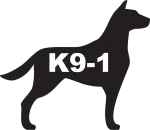Punishers are consequences that discourage the preceding behavior.
For dog training purposes these are divided into two main categories:
An unconditioned punisher (also known as a primary punisher) is a consequence that naturally is undesirable to a dog. Examples of these would be a leash correction, remote collar stimulation, a noise that startles the dog, and an aggressive tone of voice directed at the dog. A punisher does NOT necessarily need to be something uncomfortable or scary to the dog. For instance, It can be the removal of something desirable to the dog (such as affection/play/food). A person needs to do nothing to teach a dog that these are undesirable consequences. Dogs naturally want to avoid these outcomes. Since the dog does not need to be conditioned to dislike these punishers they are known as unconditioned punishers.
A conditioned punisher (also known as a secondary punisher) is a stimulus that starts off as neutral to a dog. Examples are a beep from a collar or a calmly spoken word. Normally these will not encourage or discourage behaviors and cannot be used as effective consequences. After being paired with an unconditioned punisher it will eventually elicit a similar reduction of behavior as that natural punisher it was paired with. When this occurs that neutral stimulus has been conditioned to be closely associated with the natural punisher, can be used by itself as a consequence to reduce a behavior, and therefore can be called a conditioned punisher.
Examples:
The word "no" spoken calmly means nothing to a dog. This is a neutral stimulus. But, if the word "no" is spoken calmly just before a dog is corrected with a leash for breaking a command, eventually the dog will return to the proper position with the word "no" alone. If the word "no" proves to discourage the behavior of breaking the command again in the same way the actual leash correction did it is now considered a conditioned punisher.
Another great example of this is an invisible fence system. The unconditioned punisher is usually a highly aversive electric stimulation. Most dogs that experience the correction from an invisible fence system will not challenge it again if they understand how to avoid it. Since the collar emits an audible tone just before the electric correction an association is quickly made with the tone and correction. If the dog is properly trained it will react to the tone only and run away from the boundary before the electric correction is triggered in the same fashion as if he was actually corrected. Many of these dogs will go a lifetime without ever getting another electric correction. The audible tone is considered a conditioned punisher because the tone by itself is enough to discourage the preceding behavior of going near the boundary. This saves most dogs many electric corrections for making the honest mistake of getting too close to the invisible boundary while at the same time maintaining a dog on a consistent and continuous punishment schedule which will provide the best reliability and least amount of challenges from the dog.
One more example that does not involve the use of an aversive is a dog that chews the owner's hands while receiving affection. If the owner calmly says "no" then removes the attention and walks away, soon the word "no" will be associated with the consequence of the affection removal. Eventually the word "no" by itself will serve as a conditioned punisher and the dog will restrain from the behavior of mouthing when hearing the word "no" because of its close association with the undesirable consequence of lost attention.
The long-term effectiveness of conditioned punishers relies on its close association with actual unconditioned punishers. Therefore if the word "no" in obedience training or the "tone" from the invisible fence collar fails to discourage the undesired behavior, each should immediately be followed by their perspective unconditioned punishers to refresh the association.
The proper use of conditioned punishers allows the trainer to maintain a dog on a continuous punishment schedule, which is the most effective schedule for reliable training, while greatly reducing the amount of natural punishers.
The proper use of unconditioned punishers is one of the most important skills for a dog trainer to learn in order to systematically reduce the amount of unnecessary natural corrections during training and maintain the modified behaviors of dogs.
For more on the use of punishment from a scientific perspective see operant conditioning.


Responses